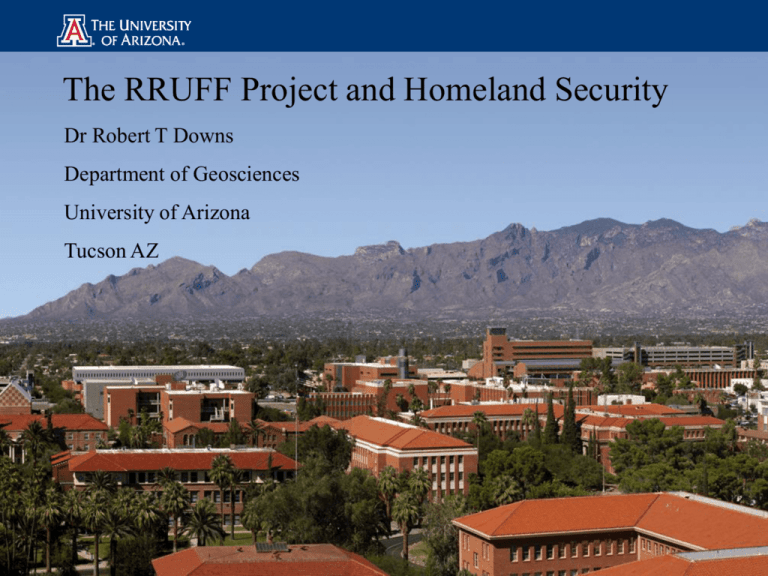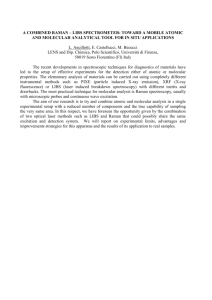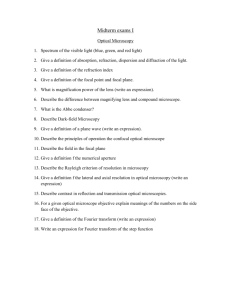Downs-RRUFF-Raytheon
advertisement

The RRUFF Project and Homeland Security Dr Robert T Downs Department of Geosciences University of Arizona Tucson AZ The RRUFF Project and Homeland Security • Homeland Security Depends on Reliable Identification of Suspect Materials. • This Can Be Accomplished With Raman Spectroscopy Richard Reid, the Shoe bomber Raman Spectra of TATP Explosive In Shoe Is Unique Fingerprint RRUFF Project Goals • Complete Measurement of Known Minerals Via Raman Spectroscopy • Improve Accuracy and Predictability of Raman Search/match Software • Collaborate With Hardware Manufacturers to Integrate RRUFF Database With Handheld Raman Instruments • Characterize Specialized Substances for Inclusion in Database (Drugs, Explosives, Etc.) • Explore Applicability of Raman Spectra to Develop Geographic Markers for Suspect Materials Why Raman Spectroscopy? RRUFF Project Database • Quick Acquisition of Spectra • Little to No Sample Preparation • Useful on Solids, Liquids and Organics (Leaves, Seeds, Etc.) • Portable Units, Soon to Be Handheld Sized • Can Be Deployed on Robots • Database Critical to Reliable and Accurate Identification of Suspect Materials • Completion of Database Critical to Error Free Identification of Suspect Materials • RRUFF Team in Place And Proven • 50% Complete (2000 of 4300 Known Species Characterized) • Remaining Species Are More Complex – Require More Time to Characterize • Funding Required to Complete Raman Materials Characterization for Database - $1M Per Year for 5 Years Restrictions • Must Be in Close Proximity to Suspect Material • Fluorescence May Interfere • Will Not Work on Everything – Metals 2 The RRUFF Project and Homeland Security The Raman spectrum of a substance is a fingerprint that can be used to uniquely identify it. Richard Reid, the Shoe bomber Dec 22, 2001 The technique would be used to unambiguously identify targeted compounds of interest. Raman spectrum of TATP explosive that was found in his shoe. 3 The RRUFF Project and Homeland Security The RRUFF Project • The RRUFF Project at the University of Arizona is creating a Raman database of carefully characterized minerals. This means that chemical composition and X-ray diffraction are performed on each sample in order to properly identify them. Then the Raman spectrum is used to match a recorded signal to the sample. • Minerals represent the naturally occurring inorganic compounds. There are about 4300 known phases, 2000 have already been characterized by the RRUFF project. • Almost all known substances, including man-made synthetics, originated from minerals as their raw material. 4 The RRUFF Project and Homeland Security RRUFF Project Goals • Complete the measurement and characterization of the known minerals • Continue the development of the search/match software to improve its accuracy and predictability. • Identify and collaborate with hardware manufacturers to integrate the data and software with handheld instruments. • Characterize other specialized substances for inclusion in the databases, for instance, drugs and explosives. Data already exist for some of these materials, but we have developed the expertise to effectively measure any substance. • Further investigate the capability of the Raman instrument to record spectral artifacts that can be used to determine the geographical origin of a sample with certainty. 5 The RRUFF Project and Homeland Security This is not a startup operation; the RRUFF project has been running successfully for four years with a team of well-trained undergraduate and graduate students, postdocs and research scientists • Procedures are developed • Validation and verification schemes are in place • Equipment already exists The RRUFF project has been funded by the National Science Foundation, NASA, and the generosity of Michael Scott, founding president of the Apple Computer Corporation. 6 The RRUFF Project and Homeland Security Raman Spectroscopy • Raman spectroscopy offers a means to identify compounds with no sample preparation. • Recent technology is creating inexpensive and compact instruments, suitable for handheld field equipment. • Databases are required to make identification. 7 The RRUFF Project and Homeland Security A Raman signal can be created by the interaction of a laser with a substance, using specialized spectrometers. The signal is a series of Raman peaks whose positions are determined by the masses of the constituent atoms and the strength of their chemical bonds. The spectral lines produce a unique chemical and structural fingerprint of a substance. Raman spectrum of aegirine, NaFeSi2O6 8 The RRUFF Project and Homeland Security Raman Instrumentation NASA spearheaded the development of miniaturized Raman spectrometers for planetary exploration*. The technical advances are rapidly being transferred to handheld instruments, mainly in response to homeland security concerns. Here are examples of four generations of instrumentation. Typical bench top unit, circa 2000 Mars rover, conceptual design, 2003 Ahura FirstDefender, 2005 Delta Nu Reporter, 2007 *A high performance Raman spectroscopy system for Mars surface studies. (2003-2005) Co-PI: B. McIntosh (Hamilton Sundstrand Sensor Systems), M.B. Denton & R.T. Downs (U of Arizona), and W. Doyle (Axiom Analytical, Inc.) NASA 9 The RRUFF Project and Homeland Security Pros and Cons of Raman Spectroscopy for Identification Purposes Pros: • Signal can be recorded in seconds • Very little, if any, sample preparation is required • Useful on solids, liquids, even for identifying organics like leaves and seeds, representing 99% of the compounds of interest. • Portable units will soon be hand size • Can be deployed by robots Cons: • Needs a database • Instrument sensor must be near the suspect material • Fluorescence may swamp signal • Will not work for everything, metallic compounds generally do not give good spectra. Failure on about 1% of the compounds of interest. 10 The RRUFF Project and Homeland Security Example: Raman spectrum of Excedrin tablet, through the bottle With a red laser, a signal can be recorded through the white bottle, with no sample preparation. The three components of Excedrin are correctly identified. Raman Intensity Ranked list of search/match results 1 2 3 Acetylsalicylic acid 4-Acetamidophenol Caffeine These are the components of Excedrin. 300 800 1300 1800 Raman Shift (cm -1) Raman spectrum of Excedrin tablet, through the bottle Materials in certain closed containers can be identified. Another example, anthrax in an envelope. 11 The RRUFF Project and Homeland Security The Database • To effectively use Raman spectroscopy to identify unknown materials, a database is required. • Natural materials are ubiquitous. They are found entrained or attached to clothing, shoes, luggage, or computers. For example, anthrax in the US mail system was carried on a mineral binder. These natural materials represent compounds from the mineral kingdom. The project is completing the database on all the known minerals. The completion of the database will provide the proper identification of these materials in homeland security environments. • The samples are correctly identified and characterized by X-ray diffraction and chemical composition, and then their Raman spectra are collected. The result is a database of Raman spectra that can be used to correctly identify minerals. 12 The RRUFF Project and Homeland Security Database website http://rruff.info This is the front end of our project database website. 13 The RRUFF Project and Homeland Security Database contains a collection of mineral sample pages: • Photo of sample, its source and locality where sample was found • Microprobe analyses that contains detailed chemical composition A microprobe is a $1M laboratory instrument that requires several days work to produce a well-characterized chemical composition by a PhD level analyst. The technique is destructive. 14 The RRUFF Project and Homeland Security Database contains: • Oriented and unoriented Raman spectra Raman spectra of solids show intensity variation that is dependent upon the orientation of the sample and its crystallographic symmetry. The RRUFF project collects Raman spectra that are shot from all the symmetrically distinct orientations, so unknown materials can be identified regardless of how they are presented to the spectrometer. 15 The RRUFF Project and Homeland Security Database contains: • Broad ranged scan of the unoriented sample using several wavelengths of lasers One of the results of the project has been the observation that the spectrum contains more signal than just Raman. For instance, peaks are observed that are not Raman in origin. We are still learning what these other artifacts represent, though it is clear that fluorescence peaks are recorded. These are the results of minor or trace element contamination, and can be used, in some cases, to constrain the geographical origin of the sample. 16 The RRUFF Project and Homeland Security Database contains: • Infrared spectrum Another spectroscopic method for identification of unknown samples is infrared spectroscopy. This is a technique that is not uncommon to many forensic laboratories. The instruments are not miniaturized and they require sample preparation. But the method is well-established. We are including these spectra in our database. 17 The RRUFF Project and Homeland Security Database contains: • X-ray diffraction profile and refined crystallographic parameters The standard way to identify an unknown crystalline substance is to apply X-ray diffraction techniques. This is a destructive technique that requires a laboratory instrument and takes many hours to days to analyze. Every mineral that we examine is analyzed by X-ray diffraction in order to assure that it is correctly identified. 18 The RRUFF Project and Homeland Security Database contains: • Selection of the important scientific literature for additional information on the minerals In collaboration with the major professional mineralogical associations, the important papers have been collected and are made available when permission from the editors has been granted. 19 The RRUFF Project and Homeland Security The project has also developed search/match software for the unoriented Raman and X-ray diffraction measurements 20








